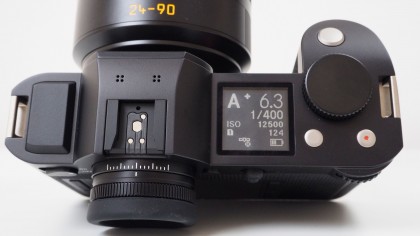Why you can trust TechRadar
Leica prides itself in the quality of the build of its cameras and the SL exemplifies the company's craftmanship. The bodyshell is milled from two blocks of aluminium, the first for the front, top, bottom and sides and the second for the back. It gives the camera a very solid feel and there are seals around the joints and controls to make it dust- and splash-proof.
Appearance-wise the SL looks more SLR than rangefinder, having a pentaprism-like lump on top where the electronic viewfinder is located. A good sized grip on the front adds to the SLR-like appearance.
Although well-sized, the grip could do with having a more ergonomic shape to make it feel more secure in your hand. This is especially true when a weighty lens like the Leica Vario-Elmarit-SL 24–90 mm f/2.8–4 ASPH is mounted as the camera becomes very front-heavy.
Leica has used a similar control arrangement on the SL to the one it has adopted for the S (Type 007) – its latest medium format camera. For example, there's a large unmarked dial on the top of the camera that's used for adjusting shutter speed and a monochrome LCD that shows key settings. Just above the thumbrest on the back of the camera is a dial that can be depressed to change what it's used for, but by default is used to adjust aperture and scroll through settings in the menu.
In addition, there are four long buttons at the sides of the screen on the back of the camera and their function changes depending upon whether you use a short or long press. It's also possible to customise their function to reach the options you use most often.
By default, pressing the button to the top left of the screen brings up the menu screen. The other three buttons can then be used to access your stored menu Favourites, the image parameters (sensitivity and white balance) etc, and the Set-up menu. It speeds up navigating the menu. A long press of the top left button reveals the sensitivity options and this can be adjusted either using a finger on the touchscreen or either the mini-joystick controller or the dial above the thumbrest.
While the short and long pressing on buttons makes good economic use of the controls, it takes a little getting used to and this could be an issue for anyone swapping between different camera models on a regular basis – unless they're swapping to a Leica S of course.
There's a button on the top of the camera that's used for switching between stills and video mode and accessing exposure compensation. I found this very awkward to reach and set the bottom right button near the screen to access this key feature.
Like the S, when the SL is in manual focus mode and shutter release is depressed halfway, the top LCD indicates the distance to the focus point as well as the back and front focus points, which could be very useful all sorts of photography, but especially landscapes.

I really liked the Q's viewfinder when I tested it and I need to use the one in the SL a bit more and in a wider range of conditions than I have so far, but my first impressions are that it is superb. It's smooth, responsive and clear.
Similarly, the main screen seems very good, showing lots of detail and responding to a touch quickly. However, I think Leica could have made more use of the touch control and made it possible to navigate the menu with swipes and taps on the screen. Nevertheless, I love how quickly the screen zooms into an image following a double tap.
